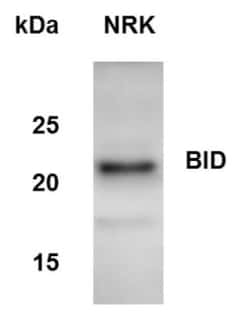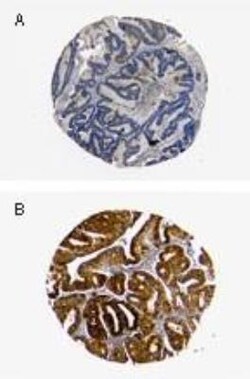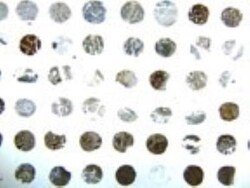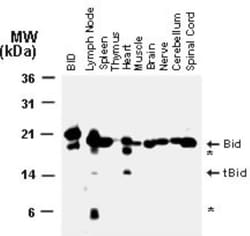Promotional price valid on web orders only. Your contract pricing may differ. Interested in signing up for a dedicated account number?
Learn More
Learn More
BID Antibody, Novus Biologicals™


Rabbit Polyclonal Antibody has been used in 6 publications
Supplier: Novus Biologicals NB10056106
Description
BID Polyclonal specifically detects BID in Human, Mouse, Rat, Canine, Gerbil samples. It is validated for Western Blot, Immunohistochemistry, Immunoprecipitation, Immunohistochemistry-Paraffin, Immunohistochemistry-Frozen.Specifications
| BID | |
| Polyclonal | |
| Western Blot 1:1000-1:2000, Immunohistochemistry, Immunoprecipitation 1:50-1:200, Immunohistochemistry-Paraffin 1:1000-1:5000, Immunohistochemistry-Frozen 1:1000 - 1:5000 | |
| apoptic death agonist, BH3 interacting domain death agonist, BH3-interacting domain death agonist, BID isoform ES(1b), BID isoform L(2), BID isoform Si6, desmocollin type 4, FP497, Human BID coding sequence, MGC15319, MGC42355, p22 BID, tbid | |
| Rabbit | |
| Unpurified | |
| RUO | |
| Primary | |
| Full-length Bid is known to undergo cleavage/truncation (reviewed in Yin, 2006). Bid was initially found to be cleaved and activated by capspase-8 following death receptor activation. The term “Bid” was first used to described the caspase-8 cleaved/truncated C-terminal Bid. Bid can be also cleaved by other proteases such as Granzyme B, calpains and cathepsin. The C-terminal portion is considered to be the active Bid moiety. This active form can translocate from the cytosol to the mitochondria. Therefore, the appearance of Bid in the mitochondria is considered to be an indication of active Bid. However, it should also be noted that Bid has been shown to translocate to the mitochondria without cleavage in some model systems. The proteolytic cleavage of Bid usually occurs in the unstructured loop region between the alpha 2 and alpha 3 helices, which is between amino acids (aa) 41 and 79 of Bid. For example, the caspase-8/3 cleavage site is at 60 (human) and 59 (mouse). It should be noted that after cleavage, the smaller N-terminal portion of Bid is not necessarily separated from the larger C-terminal portion. The exact size of the C-terminal cleavage products depends on the Bid cleavage sites; generally 11-15 kDa C-truncated cleavage forms are generated. Shorter C-terminal Bid cleavage products may result from protease cleavage that involves both caspases and other proteases. Full length Bid is quite stable, but cleaved/truncated forms may have a short half-life (less than 1.5 h) and degrade rapidly. Therefore, a time course may be useful when detecting Bid cleavage fragments. | |
| Store at 4C short term. Aliquot and store at -20C long term. Avoid freeze-thaw cycles. | |
| IgG |
| Western Blot, Immunohistochemistry, Immunoprecipitation, Immunohistochemistry (Paraffin), Immunohistochemistry (Frozen) | |
| Unconjugated | |
| Neat whole antisera with 0.05% Sodium Azide | |
| BID | |
| Full-length recombinant mouse Bid protein was used as immunogen. | |
| 0.05 mL | |
| Apoptosis, Cancer, Tumor Suppressors | |
| 637 | |
| Human, Mouse, Rat, Canine, Gerbil | |
| Antisera |
Product Content Correction
Your input is important to us. Please complete this form to provide feedback related to the content on this product.
Product Title
For Research Use Only
Spot an opportunity for improvement?Share a Content Correction



